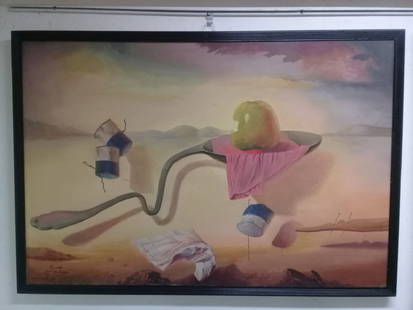
Attributed to the Master of San Ildefonso, also named the Master Tlaxcala. Circa 1625.
Similar Sale History
View More Items in PaintingsRelated Paintings
More Items in Paintings
View MoreRecommended Art
View More









Item Details
Description
Attributed to the Master of San Ildefonso, also named the Master Tlaxcala. Circa 1625. "Tota Pulchra"Oil on copper. 29 x 19,5 cm. “The Master of San Ildefonso”, or “of Tlaxcala” so-named by Rogelio Ruiz Gomar, belongs to the group of painters who arrived on a Latin American scene consolidated by previous artists. Among these new talents who arrived in New Spain, we find artists of the calibre of Baltasar de Echave IbÃa, Luis Juárez, Alonso López de Herrera, Basilio de Salazar, Gaspar de Angulo, and, of course, the aforementioned painter of our Tota Pulchra whose name, unfortunately, we do not know, but who undoubtedly rivals the most outstanding artists of this period, being today one of the greatest representatives of New Spanish painting of the period. The representation of the Tota Pulchra which became established in the Viceroyalty of New Spain has been adapted to the circumstances, being an extension of the original proposal to make certain iconographic changes. In the first place, the consolidated image of the woman of the Apocalypse became generalised. In this representation, not only were astral signs assimilated but also the rays of the sun behind her back. In many cases a hybrid solution was chosen, eliminating the phylacteries that were frequently supported by putti, and incorporating certain Marian symbols to the landscape. This is the case of the Our Lady Immaculate by the Master of San Ildefonso (Fig. 1) found in the Cathedral of Tlaxcala in which the artist opts for the incorporation of some phylacteries with the Marian symbols while others are simply integrated into the work in the bottom of landscape. In the case of the Tota Pulchra (Fig. 2) initially attributed to Manuel de Echave Orio and which was later exhibited and attributed to the Master of San Ildefonso in the Pintura de los Reinos (Painting of the Kingdoms) exhibition that passed through the Prado Museum in the years 2010- 2011 and in its corresponding catalogue, the painter only tells us of her pure character with the use of a Phylactery in which we read the inscription “Toda hermosa, eres tú, amiga mÃa, y no hay mancha en ti” (You are all beautiful, my friend, and there is no stain on you). In this case, the Marian symbols are immersed between the landscape in the background and the angelic figures that support them. This is where a series of differences can be seen between the two works previously mentioned when establishing an iconographic analysis, but similar technical characteristics are certainly present, such as the anatomy of the bodies, in which the drawing of the hands particularly stands out, as well as the almond-shaped faces and the slightly foreshortened perspective to one side of both Virgins as well as the colour palette used. The ornamental richness in the brocade of the cloth that dresses the Mother of God with purity is also remarkable in both works. Apart from the technical differences that exist between the production of large-scale works on canvas when comparing the painting exhibited in our auction room, which has been done on a small scale and on a very different medium, that is, on copper, we can also perceive here the same similarities mentioned between the two Marian canvases. This painting has a cultural export permit.Our copper is based on an engraving by Ph. Tomassin after Federico Barocci.Bibliographic references:- Rogelio Ruiz, Gomar, “Pintura de los reinos identidades compartidas, territorios del Mundo Hispánico, siglos XVIXVIII”, t. II, coordination by Juana Gutiérrez Haces, introduction by Jonathan Brown (Mexico: Fomento Cultural Banamex, 2008)- Various authors. “Pinturas de Los Reinos. Identidades compartidas en el mundo hispánico” (Palacio Real y Museo Nacional del Prado, Madrid, October 2010-January 2011)- Cuadriello, Jaime “Malinche y Tlaxcala, Una personificación: Territorios, pueblos e instituciones.” (H. Ayuntamiento de Tlaxcala, Tlaxcala, Mexico 2019)
Buyer's Premium
- 29% up to €50,000.00
- 29% up to €1,000,000.00
- 29% above €1,000,000.00
Attributed to the Master of San Ildefonso, also named the Master Tlaxcala. Circa 1625.
Estimate €5,000 - €7,500
2 bidders are watching this item.
Get approved to bid.
Shipping & Pickup Options
Item located in Barcelona, Barcelona, esSee Policy for Shipping
Payment

Related Searches
TOP

















































![Emilio Grau-Sala "Sur la Plage" Oil on Canvas: Emilio Grau-Sala (Spanish, 1911-1975), "Sur la Plage" [On The Beach], Oil on Canvas, 1958, signed "Grau Sala" lower right, signed, inscribed "Trouville", dated, and titled to verso. Image: 21.5" H x 2](https://p1.liveauctioneers.com/5649/328023/176731071_1_x.jpg?height=310&quality=70&version=1714409606)














![[SEX] LOT OF 9 PHOTOGRAPHS SOLD TOGETHER: [SEX] A lot of 9 photographs sold together. Some postcards. One mounted with plastic corners in archival mat. Prints: 4.5" x 3" - 6" x 4". Generally good condition, various imperfections. *Additional](https://p1.liveauctioneers.com/8124/329546/177689790_1_x.jpg?height=310&quality=70&version=1715469494)

